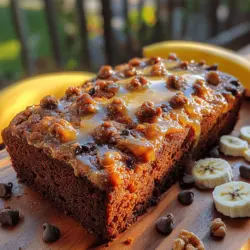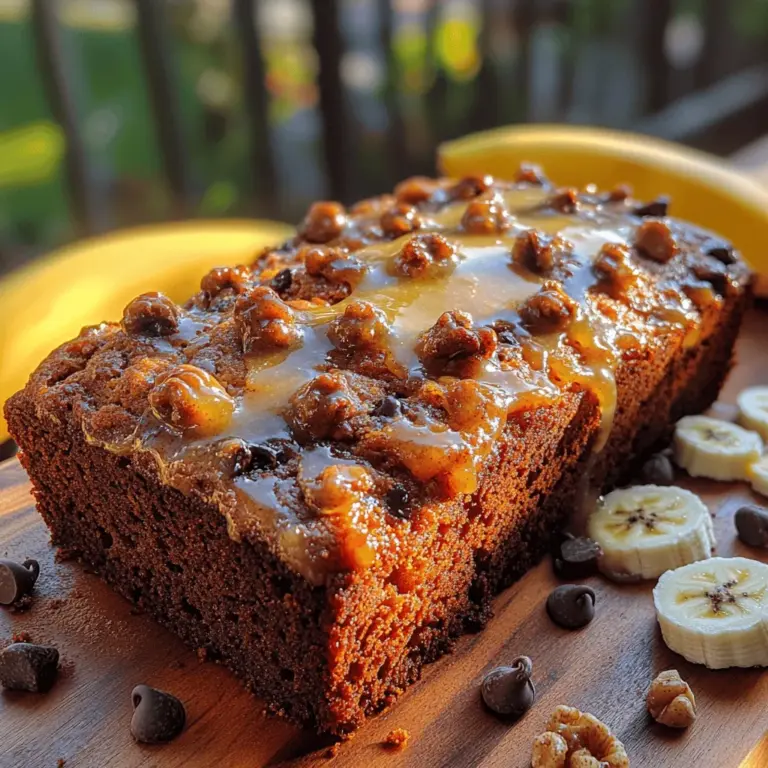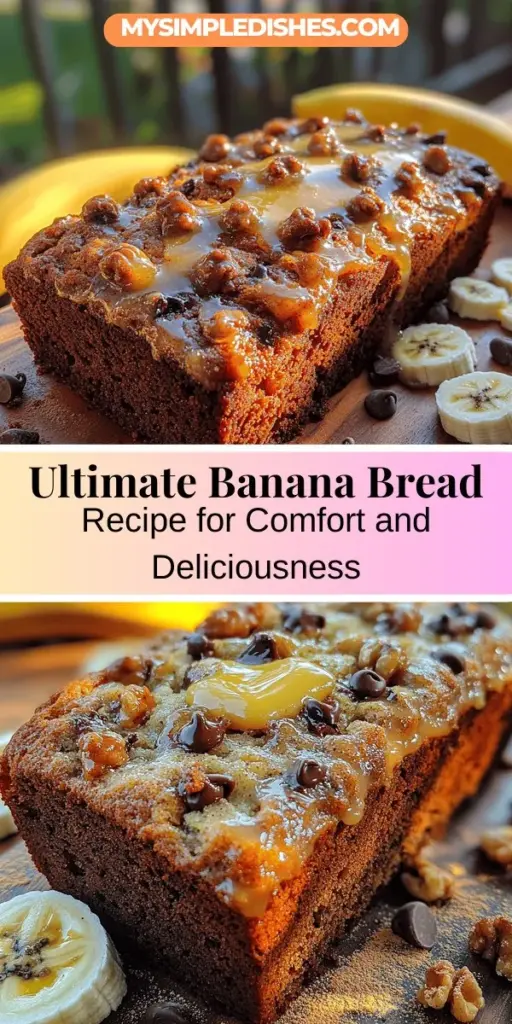Banana bread is more than just a baked good; it’s a cherished classic that has found its way into kitchens and hearts for generations. Its warm, inviting aroma wafting through the house is a nostalgic reminder of home and comfort. This delightful Banana Bread Delight recipe takes the traditional loaf and elevates it to a whole new level of deliciousness. With a moist texture, rich flavor, and the option to add warm spices or indulgent ingredients like chocolate chips and nuts, this recipe is the perfect solution for those overripe bananas that may otherwise go to waste. In this article, we will dive into the essential ingredients that make this banana bread truly special, explore the science behind its perfect rise and texture, and guide you through the step-by-step instructions to create your own loaf of Banana Bread Delight.
Understanding the Ingredients
To create a mouthwatering loaf of banana bread, it is essential to understand the key components that contribute to its unique flavor and texture. Each ingredient plays a crucial role, and understanding these components will help you achieve the best results possible.
Ripe Bananas: The Foundation of Flavor and Moisture
The star of the show in any banana bread recipe is, of course, the bananas. Using ripe bananas is critical for flavor development; they should be heavily speckled with brown spots to signify optimal ripeness. The natural sugars in ripe bananas caramelize during baking, imparting a rich sweetness and moisture that is essential for a tender loaf. If you find yourself with overripe bananas, don’t toss them out—this is the perfect opportunity to make banana bread!
Butter: Adding Richness to the Bread’s Texture
Butter is another key ingredient that adds richness to the banana bread. When combined with the bananas, it contributes to a tender crumb and enhances the overall flavor. For the best results, use unsalted butter that has been melted. This allows for easier incorporation into the batter and helps create a consistent texture throughout the loaf.
Vanilla Extract: Enhancing Overall Flavor
Vanilla extract is a subtle yet essential addition that rounds out the flavor profile. It adds warmth and depth, enhancing the sweetness of the bananas and balancing the other ingredients. A splash of pure vanilla extract elevates your banana bread from good to extraordinary.
Baking Soda and Salt: The Key to Leavening and Balance
Baking soda is the leavening agent in this recipe, helping the bread to rise and achieve the perfect texture. When combined with the acidity of ripe bananas, baking soda reacts to produce carbon dioxide bubbles that create air pockets in the bread, resulting in a light and fluffy loaf. Salt, on the other hand, plays an important role in enhancing flavors and balancing the sweetness. A small pinch goes a long way in creating a well-rounded taste.
Brown Sugar: Contributing to Sweetness and Moisture
Brown sugar is preferred in this recipe for its rich flavor and moisture content. The molasses found in brown sugar not only adds sweetness but also contributes to a denser, more flavorful loaf. If you’re looking for a sweeter and more caramelized taste, dark brown sugar can be used, but light brown sugar will work just as well.
Egg: Binding the Ingredients Together
An egg acts as a binding agent in banana bread, helping to hold all the ingredients together. It also adds moisture and contributes to the overall structure of the loaf. For a vegan option, you can replace the egg with a flaxseed meal or applesauce, ensuring that your banana bread remains delicious and cohesive.
All-Purpose Flour: The Structural Base of the Loaf
All-purpose flour is the backbone of the banana bread, providing the structure needed to support the moist ingredients. The flour absorbs the moisture from the bananas and butter, creating a tender crumb. It’s important to measure the flour accurately, as too much can lead to a dry loaf. Spoon the flour into your measuring cup and level it off for the best results.
Optional Ingredients: Walnuts, Pecans, and Chocolate Chips for Added Flavor and Texture
While the basic banana bread recipe is delightful on its own, feel free to customize it with optional ingredients that suit your taste. Chopped walnuts or pecans add a satisfying crunch and nutty flavor, while chocolate chips introduce a touch of sweetness that pairs beautifully with the bananas. You can also experiment with spices like cinnamon or nutmeg for a warm, aromatic twist.
The Science Behind Banana Bread
Understanding the science behind banana bread can help you troubleshoot any issues and optimize your baking results. Each ingredient interacts with the others to create the perfect loaf.
The Role of Ripe Bananas in Flavor Development
Ripe bananas are essential not just for moisture but also for the complex flavors they develop. As bananas ripen, their starches convert to sugars, resulting in a sweeter fruit that also breaks down to create a smoother batter. The natural sugars caramelize during baking, contributing to the loaf’s golden color and rich flavor.
The Importance of Baking Soda as a Leavening Agent
Baking soda plays a pivotal role in achieving the perfect rise in banana bread. When combined with the acidity present in the ripe bananas, baking soda releases carbon dioxide gas, which creates bubbles in the batter. These bubbles expand during baking, causing the bread to rise. It’s crucial to use fresh baking soda, as expired soda will not produce the necessary leavening effect.
Balancing Moisture with Flour for Ideal Texture
The interplay between flour and moisture is crucial in creating the perfect banana bread texture. Too much flour can lead to a dry loaf, while too little can result in a dense, gummy texture. The goal is to find the right balance by measuring ingredients accurately. As you mix the batter, be careful not to overmix, as this can develop gluten and lead to a tough loaf.
How Spices Enhance the Overall Taste Profile
Spices can elevate banana bread from a simple snack to a flavorful treat. Cinnamon, nutmeg, and even allspice can enhance the natural sweetness of the bananas while adding warmth and depth. Experimenting with spices allows you to create a unique flavor profile that reflects your personal taste.
Step-by-Step Instructions for Making Banana Bread Delight
Now that we have a solid understanding of the ingredients and their roles, let’s dive into the step-by-step instructions for making your Banana Bread Delight.
Preheat the Oven and Prepare the Loaf Pan
The first step in your banana bread journey is to preheat your oven to 350°F (175°C). Preheating ensures that the bread bakes evenly and helps achieve a nice rise. While the oven is heating up, prepare your loaf pan. You can either grease the pan with butter or oil to prevent sticking or line it with parchment paper for easy removal. If you choose the latter, make sure to leave some overhang so you can easily lift the loaf out once baked.
Mixing the Wet Ingredients
In a large mixing bowl, start by mashing your ripe bananas with a fork or potato masher until they reach a smooth consistency. Next, add the melted butter into the mashed bananas and mix well. The warmth of the melted butter will help incorporate the bananas better. Follow this by adding the vanilla extract and the egg, whisking until everything is combined.
Preparing the Dry Ingredients
In a separate bowl, whisk together the all-purpose flour, baking soda, salt, and brown sugar. Make sure to break up any lumps of brown sugar to ensure even distribution. If you’re using spices, now is the time to add them into this mixture. Mixing the dry ingredients separately helps to ensure that the baking soda and salt are evenly distributed throughout the flour, which is critical for consistent rising.
This detailed exploration of the ingredients and the initial steps of making Banana Bread Delight sets the foundation for a delicious and satisfying baking experience. Stay tuned for the next part, where we will continue with the mixing process and the final steps to create this delightful treat.
{{image_1}}
Combining Wet and Dry Mixtures
When it comes to baking the perfect banana bread, one of the key steps is the combination of wet and dry ingredients. Achieving a harmonious blend without overworking the batter is crucial. Over-mixing can lead to a dense, chewy texture that detracts from the light, fluffy quality we’re aiming for.
Techniques for Mixing Without Overworking the Batter
To avoid over-mixing, start by creating a well in the center of your dry ingredients. Pour your wet mixture (which includes mashed bananas, eggs, melted butter, and vanilla extract) into this well. Using a rubber spatula or a wooden spoon, gently fold the wet ingredients into the dry ingredients. Focus on combining them just until you see no more dry flour. It’s perfectly fine if there are a few small lumps; these will incorporate during baking, leading to a tender crumb.
Remember, the goal is to hydrate the flour without activating too much gluten. Gluten development happens with excessive mixing, leading to a tougher loaf. So, treat your batter with care, and you’ll be rewarded with a beautifully tender banana bread.
The Impact of Over-Mixing on the Bread’s Texture
Over-mixing can result in a banana bread that is more akin to a brick than a soft, airy treat. The gluten formed from the flour creates a strong network that, while beneficial for some baked goods, is undesirable in banana bread. To ensure a light texture, always prioritize gentle mixing. If you’re uncertain, err on the side of caution and mix less rather than more.
Adding Optional Ingredients
To elevate your banana bread experience, consider adding optional ingredients like nuts or chocolate chips. These can provide delightful texture and flavor contrasts, enriching your loaf.
Suggestions for Incorporating Nuts and Chocolate Chips
If you decide to include nuts, walnuts and pecans are traditional favorites. For a more indulgent twist, semi-sweet or dark chocolate chips can be a delicious addition. Aim for about ¾ to 1 cup of your chosen add-ins, adjusting based on your preference.
When it comes to incorporating these optional ingredients, folding them into the batter is key. After you’ve completed the initial mixing of wet and dry ingredients, sprinkle the nuts or chocolate chips over the top of the batter. Use your spatula to gently fold them in, ensuring they are evenly distributed without overworking the batter. This technique helps maintain the desired texture while enhancing flavor.
Baking the Banana Bread
Now that your batter is ready, it’s time to bake! The baking process is critical to achieving that perfect loaf.
Timing and Temperature: Achieving the Perfect Bake
Preheat your oven to 350°F (175°C). A consistent temperature is vital for even baking. Pour your batter into a greased loaf pan, smoothing the top with a spatula. Bake for 50 to 60 minutes, but keep an eye on it as oven temperatures can vary.
Recognizing When the Bread is Done Using the Toothpick Test
To check for doneness, use the classic toothpick test. Insert a toothpick into the center of the loaf; if it comes out clean or with just a few moist crumbs, your banana bread is ready. If the toothpick comes out with wet batter, give it an additional 5 to 10 minutes in the oven, checking periodically.
Cooling and Serving Suggestions
Once your banana bread is baked to perfection, the next step is crucial: cooling. Proper cooling methods will ensure that the texture remains ideal for enjoying.
Proper Cooling Methods to Maintain Texture
After removing the loaf from the oven, let it cool in the pan for about 10 minutes. This allows it to set slightly, making it easier to remove. Then, carefully transfer the loaf to a wire rack to cool completely. This step is essential as it prevents the bottom from becoming soggy while allowing air to circulate around the bread.
Enjoying Banana Bread Warm, at Room Temperature, or Toasted
Banana bread can be enjoyed in various ways. Many people love it warm from the oven, perhaps with a pat of butter melting into the moist crumb. However, it’s also delicious at room temperature or even toasted for an added crunch. Consider serving it with a spread of cream cheese or a drizzle of honey for an extra touch of indulgence.
Nutritional Benefits of Banana Bread
Banana bread isn’t just a delicious treat; it also offers some nutritional benefits, depending on the ingredients you choose. Let’s explore a few key components.
Bananas: A Source of Essential Vitamins and Minerals
The star ingredient, bananas, are packed with essential vitamins and minerals. They are a great source of potassium, which supports heart health and helps maintain proper muscle function. Additionally, bananas provide vitamin C and vitamin B6, both important for immune function and energy metabolism. The natural sweetness of bananas also allows you to reduce added sugars in your recipe.
Nuts: Adding Healthy Fats and Protein
If you choose to incorporate nuts, you’re adding healthy fats and protein to your banana bread. Nuts such as walnuts and almonds provide omega-3 fatty acids, which are known for their heart health benefits. They also contribute fiber, which aids in digestion and helps keep you feeling full longer.
The Nutritional Trade-Offs of Using Chocolate Chips
While chocolate chips add a delightful taste, they do introduce additional sugars and calories. However, using dark chocolate chips can mitigate some of the downsides, as dark chocolate contains antioxidants and less sugar than its milk chocolate counterpart. The key is moderation; a small amount of chocolate can enhance your banana bread without overwhelming its health benefits.
The Variations of Banana Bread
Banana bread is incredibly versatile, allowing for creative twists on the classic recipe. Whether you’re looking for gluten-free options, vegan alternatives, or unique flavor profiles, there’s a version for everyone.
Gluten-Free Banana Bread Alternatives
If you’re looking for a gluten-free option, consider substituting regular flour with a gluten-free all-purpose flour blend. Many blends are formulated to mimic the properties of wheat flour, ensuring that your banana bread remains tender and flavorful. You may also want to add a binding agent like xanthan gum, which helps mimic the elasticity of gluten.
Vegan Options for a Plant-Based Delight
For those following a vegan lifestyle, banana bread can easily be adapted. Replace eggs with flaxseed meal (1 tablespoon of flaxseed meal mixed with 2.5 tablespoons of water equals one egg) or use unsweetened applesauce for moisture. Substitute the butter with coconut oil or a plant-based margarine. With these adjustments, you can enjoy a moist and delicious vegan banana bread.
Flavor Variations: Adding Spices, Fruits, or Other Nuts
Feel free to experiment with flavor variations. Adding spices like cinnamon, nutmeg, or ginger can enhance the depth of flavor. You can also fold in shredded coconut, dried fruits like raisins or cranberries, or even other fresh fruits such as blueberries for a delightful twist. Each addition offers a unique flavor experience, allowing you to customize your banana bread to your liking.
Cultural Significance of Banana Bread
Banana bread holds a special place in American culture and has a rich history worth exploring.
Origins of Banana Bread in American Cuisine
The origins of banana bread can be traced back to the 1930s, during the Great Depression, when resourcefulness in the kitchen became necessary. Home bakers began utilizing overripe bananas that would otherwise go to waste. Recipes started appearing in cookbooks, reflecting the necessity of using what was available while creating something delicious.
How the Recipe Has Evolved Over the Decades
As the years went by, banana bread evolved from a simple, practical recipe to a beloved treat enjoyed in many households. Variations emerged that incorporated different flavors and ingredients, adapting to changing tastes and dietary preferences. Today, banana bread is often featured in cafes and bakeries, showcasing its enduring popularity.
The Role of Banana Bread in Various Cultures Today
Globally, banana bread has transcended its American roots. In many cultures, it symbolizes comfort and home. Countries with abundant banana crops, such as those in the Caribbean and parts of Africa, have their own unique takes on banana bread, often infused with local flavors and ingredients. This adaptability speaks to the universal appeal of banana bread, making it a cherished dish across diverse culinary landscapes.
Conclusion: Embracing the Joy of Baking Banana Bread
Banana Bread Delight is more than just a recipe; it’s a warm embrace of comfort and nostalgia. By following the straightforward steps and understanding the ingredients, anyone can create a delicious loaf that brings joy to family gatherings or quiet evenings at home. Whether enjoyed fresh from the oven or as a delightful breakfast treat, this banana bread is sure to become a cherished staple in your kitchen.
The combination of simple ingredients, the ease of preparation, and the comforting aroma that fills your kitchen make baking banana bread an enjoyable experience. As you slice into that golden-brown loaf, you’ll not only savor the delightful flavors but also appreciate the memories created in the process. So gather your ingredients, embrace the joy of baking, and treat yourself to a slice of homemade banana bread today.


